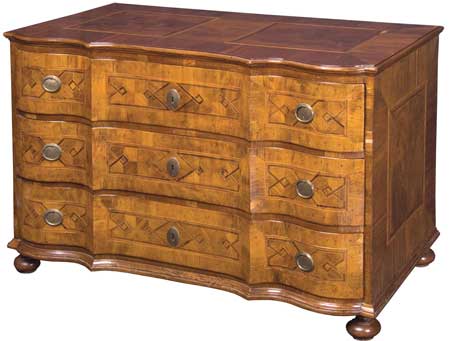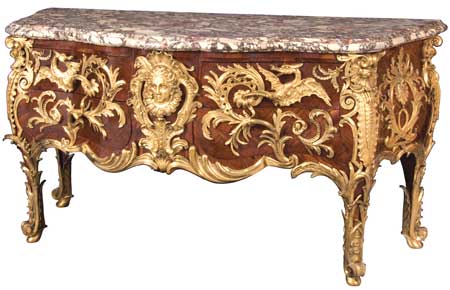The collection consists of 26 commodes from the Department of Period Furniture and Wood, which has gradually been formed since the foundation of the Museum, thanks to Dr. Verena Han and Mirjana Jevrić Lazarević and, since 1995, Marija Bujić. The latest commode was purchased recently so as to complete and enrich this charming, elegant gallery of exhibits, spanning a period from the XVII to the XX century, in all the beauty of its baroque, classicist or Biedermeier forms.
The exhibition of commodes has also provided an excellent opportunity for the Museum’s conservation expert, Milan Andrić, to demonstrate his valuable work in the maintenance of period furniture, whereby he has painstakingly restored the items of this outstanding collection to their former splendour.
The appearance of commodes was inseparably connected with the historical setting at the end of the XVII and beginning of the XVIII century. Social, economic and political circumstances had an important influence on the progress of furniture-making, and on the appearance of certain types that did not merely have a utilitarian function, but were also an object of prestige and satisfying man’s highest aesthetic needs.
The baroque period was marked by the gradual decline of feudalism and the rise of the absolutist monarchy. The Church fought to regain the position it had lost, undermined by the Reformation movement. Mercantilist economic policy strove towards the creation of a unified national market. Craftsmen were still the main producers, associated in guilds, but state and private manufacturing shops were already being created. Commodity exchange was strengthened by overseas trade and the establishment of profitable merchant companies, whereas locally, it took place at fairs and through travelling salesmen.
The rulers of the new independent states began placing orders with domestic artists and craftsmen, encouraging them to create specific national styles, modeled on the works seen in the centres of baroque visual and applied arts, in Italy and France. The fact that King Louis XIV revoked the Edict of Nantes in 1685 contributed to the rapid development of art in those countries, resulting in many excellent artists leaving France and moving to Holland, England, Germany and other European countries.
After the first civil revolutions in Holland and England, the middle class had gradually strengthened. Cities expanded, new large urban centres were built, such as Rome, Paris and London, and new prospects were built at the heart of the cities around their dominant buildings – the palaces, churches or squares. Architects made sure the facades of of the architectural complexes looked out onto cultivated gardens and parks with pools, artificial lakes, sculptures, fountains and pavilions.
Essentially, baroque architecture was the reflection of the large systems of the XVII and XVIII centuries: the centralised French state and the Catholic Church. The monarch’s court also dictated the way of life, which, in a more modest variant, reflected on the lives of the petty aristocracy and, simply, on the lives of well-to-do citizens.
The new class of wealthy merchants wanted to confirm their power publicly, by erecting magnificent buildings, modeled on the palace, equipped with furniture made of costly materials.
City residential houses essentially retained the renaissance concept of space but in the baroque period, the rooms in a house were divided according to their function, which was not the case previously. The interior of a city house tended to focus more on comfort than on being representative.
In order to demonstrate its power and might during the XVII century, the Catholic Church, personified in the Pope as its supreme head, played a crucial role in shaping and spreading the baroque style in all fields of art, by commissioning the construction of new churches, monuments, fountains and buildings in Rome. After King Louis XIV came in power in 1661, France took over the lead in the further development of baroque art.
The palace in Versailles represents an impressive example of baroque architecture, which served as the model for many palaces in Europe. The interior of the palace was decorated in keeping with the lavish external architecture. An illusion of space was primarily sought in this interior, in which there was no limitation in the use of expensive materials. Lavish furniture fitted in perfectly with the whole baroque scenery, striving to create impressive effects. Sheared velvet, damask, brocade or needlepoint fabric with motifs adapted to the shape a particular item, were used on upholstered furniture. The walls were decorated with Dutch or French tapestries, and floors were covered with expensive carpets. Besides carving, techniques were applied decorating furniture, in which the finest materials were used: exotic and rare kinds of wood, such as ebony, palisander, sycamore, lemon tree and others, but also ivory, pearls, mother-of-pearl, silver and gold.
The commodes, which underwent gradual phases of transformation during the XVII century, at the end of the century rapidly emerged in the forefront of this kind of setting as formed and definitely shaped objects and almost instantly won the central place in the stately rooms of palaces.
The first half of the XVIII century brought about political, social and economic changes in the European countries. Italy completely lost its influence in the cultural policies of Europe. The power of the English and Prussian monarchies grew, which led to the erection of a larger number of royal palaces. A more relaxed cultural climate and the strengthening of the middle class resulted in the rapid construction of smaller, comfortable palaces for the lesser aristocracy and citizens. These buildings were characterised by less formal, more elegant and comfortable interiors. The size and splendour of the XVII century baroque style acquired lighter, more bouyant and more delicate forms that led to rococo.
The process of the transformation of living space, initiated in the previous century, culminated during the XVIII century. It was then, more than ever, that the interior decoration improved in both middle class homes and the palaces of the aristocracy; space became more appropriate for the everyday life of people. These changes, in the most beautiful way, produced the thriving artistic crafts and meticulous handiwork that made furniture both an attribute of prestige and wealth, and an object of enjoyment, relaxation and leisure.
The commodes created in this period bear the hallmark of the outstanding imagination of cabinet-makers in creating unique shapes, which represent veritable jewels in the European history of furniture.
The French revolution in 1789 marked the end of the XVIII century, heralding the social changes that were to take place in the XIX century. During the XIX century, the production of commodes grew at an increasing rate. Having essentially lost its supremacy, as the most luxurious object in the main rooms, the commode became a customary item in all the other parts of a house, and the number of its various utility functions quickly increased, and thus it became the sovereign ruler in luxury and modest interiors alike.




























